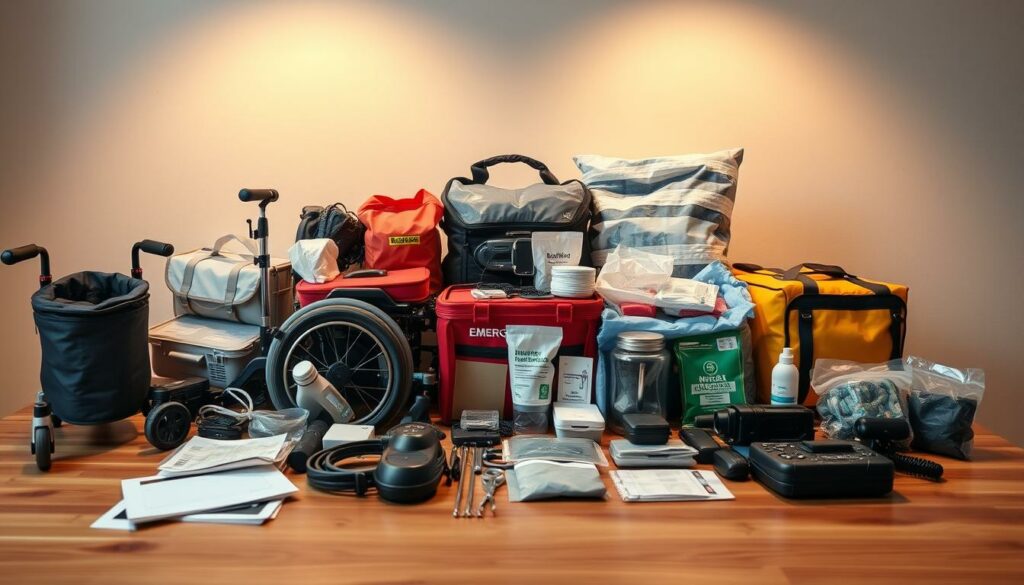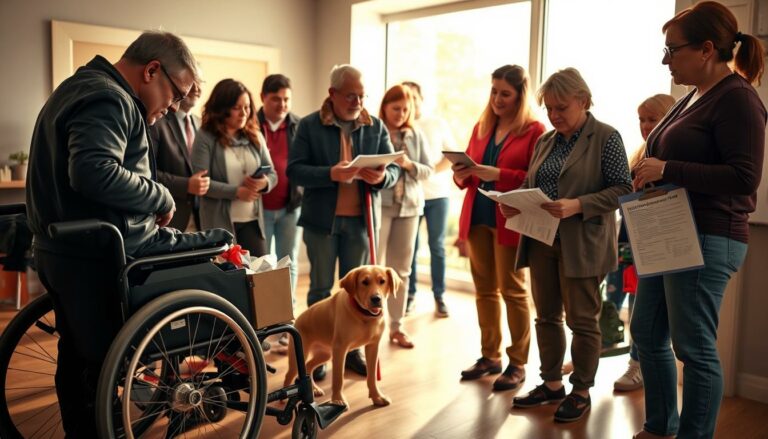Emergencies can happen anytime, putting unprepared people at risk. For the 61 million Americans with disabilities, the danger is greater. It’s important to prepare for emergencies like natural disasters, power outages, or medical crises.
It’s key to understand the challenges people with disabilities face in emergencies. About 26% of adults in the U.S. have disabilities, ranging from visible to invisible. They need special plans, as 50% might need help evacuating. Yet, 78% haven’t made an emergency kit, showing a big gap in readiness.
Emergency plans should be tailored to meet special needs. This includes communication plans and evacuation routes that are accessible. Sadly, only 36% of plans include provisions for people with disabilities. It’s vital to practice these plans to make sure they work.
Having a support network is critical during emergencies. But, 47% of people with disabilities lack such a network. Having a buddy system in emergency plans makes 70% feel safer. This shows how important having trusted people to rely on is.
Power outages can be a big problem for those who need medical equipment. It’s worrying that 34% of these individuals are not ready for such situations. Having backup power and keeping emergency medical info up to date can help a lot.
Key Takeaways
- 26% of Americans have disabilities, highlighting the need for inclusive prepping.
- 50% of people with disabilities may need assistance during emergencies.
- 47% lack a personal support network for emergencies.
- 34% relying on medical equipment are unprepared for power outages.
- 75% have not practiced evacuation plans, stressing the need for regular drills.
Understanding Specific Needs in Emergency Situations
Emergency preparedness is all about recognizing specific needs. People with disabilities face unique challenges. They need inclusive emergency response strategies to ensure safety for everyone.
Visible and Invisible Disabilities
Not all disabilities are easy to see. Some, like visual and mobility impairments, are more obvious. But mental health conditions and cognitive disabilities are not always visible.
For example, people with spinal cord injuries struggle with extreme heat. They can’t sweat properly. Those with cognitive disabilities, like Alzheimer’s, might have trouble saying they’re uncomfortable in emergencies.
Also, about 50% of Americans take daily medications. Running out of these during emergencies is a big problem.
Impact on Emergency Preparedness
Emergency plans must consider these diverse needs. Voluntary registries help cities and counties assist better. Local transit and emergency agencies offer accessible rides for evacuations.
Direct deposit is a good idea for federal benefits. It ensures money keeps coming even when mail stops.
To prepare well, make a personal list of what you need. Include emergency supplies, contacts, and medical info. Register with utility companies for help with dependent equipment. Being part of community plans for disasters is also key.
Building a Support Network for Emergency Preparedness
Millions of Americans with disabilities face big challenges in emergencies like fires and floods. It’s key to have strong support networks for personal safety. This ensures people with disabilities get the help they need in crises.
Creating a Personal Support Network
To build a good support network, pick at least three people for each place you often visit. This makes sure help is there when needed. Here’s how to make a strong support system:
- Identify trustworthy allies: Choose family, friends, neighbors, and caregivers who can help in emergencies.
- Exchange emergency contacts: Make sure everyone has the latest contact info, with different ways to reach out.
- Conduct personal assessments: Think about what you need daily, like bathing and grooming, and plan for those tasks.
- Register with local authorities: Tell local emergency services about your special needs for faster help in emergencies.
- Coordinate with utility companies: If you need electricity, tell the utility companies to help during power outages.
Roles and Responsibilities of Network Members
Each support network member should know their role for better personal safety. They need to be ready to help in different ways, like:
- Resource access: Make sure you have what you need and can get more if needed.
- Evacuation assistance: Help with getting to safety, which is important for 30% of people with disabilities.
- Post-disaster support: Keep helping after the emergency is over.
- Communication facilitation: Stay in touch and keep family and authorities updated.
About 34% of people with disabilities need caregivers in emergencies. Knowing your role in the network helps everyone recover faster, up to 40%. Having a good support network is key to being ready for emergencies.
People with disabilities are 2 to 4 times more likely to need help in emergencies. This shows how important strong support networks and good plans are. Almost 43% of people with disabilities struggle to find safe places in emergencies, making these networks vital.
Adapting Daily Routines for Emergency Situations
Making daily routines ready for emergencies is key, more so for those with disabilities. Changing routines can greatly help in staying safe and independent during crises. This is called daily prepping, where daily activities are tweaked to fit emergency plans when needed.
Adapting personal care routines is a big part of being ready. Make sure hygiene products and medical supplies are easy to get to. It’s smart to have a week’s worth of meds and any needed medical gear should work without power, with extra batteries ready.
Keeping things clean is also important. Aim for one gallon of water per person for three days. This helps a lot in staying healthy.
Household upkeep is also part of getting ready. Keep a three-day supply of food that won’t spoil, and don’t forget a can opener if you need one. Your emergency kit should have a radio that runs on batteries or can be cranked, extra batteries, and copies of important papers like family records and medical info in a waterproof bag.
Building a strong support network is also key. Family, friends, and caregivers should know the emergency plan and what they need to do. For example, if you have mobility issues, find ways to get around that are easy to use. If you need life-saving equipment, make sure you have more than one place to use it.
Every little change, from organizing meds to building a support team, helps a lot. These steps help keep people independent and safe during emergencies.
- Ensure personal care and medical supplies are accessible
- Store at least one gallon of water per person per day
- Maintain a supply of non-perishable food for three days or more
- Keep a battery-powered or hand-crank radio and extra batteries
- Store important documents safely in a waterproof container
- Identify accessible transportation options
Transportation Strategies During Emergencies
In emergencies, having reliable transportation is key, more so for those with disabilities. It’s vital to have emergency transport, accessibility services, and evacuation plans ready. This planning can greatly reduce risks for the 15% of Americans with disabilities.
Accessible Transportation Options
During emergencies, crowded and blocked roads can be big problems. For 19% of people with mobility issues, using regular transport is hard or impossible. That’s why having vehicles with wheelchair lifts is a must. Knowing about these services and how to use them is very important.
Registered Accessible Transit Services
Local governments and private companies offer special transit services for emergencies. Joining these networks can greatly help those needing special help during evacuations. Even though exact numbers are not available, these services are vital for safety.
Here’s a table to help you prepare for accessible transit services:
| Service Name | Provider | Features |
|---|---|---|
| Paratransit | Local Government | Wheelchair accessible, door-to-door service |
| Access-A-Ride | New York City | 24/7 service, advanced scheduling |
| MetroAccess | Washington Metropolitan Area Transit Authority | Vehicle tracking app, personal care attendant fare |
| ADA Paratransit | Various Cities | Service up to 3/4 mile from fixed-route transit |
Medical Prepping for Emergencies
It’s key for people with disabilities to be ready for emergencies. Having a solid medical plan can greatly improve safety. We’ll look at important steps like keeping medical info ready, setting up power for medical gear, and finding different healthcare places.
Maintaining Emergency Medical Information
Being ready means having quick access to important medical details. This includes a full list of medicines, allergies, health issues, and emergency contacts. Keeping this info on a portable device, like a USB or printed card, helps first responders act fast.
Backup Power Solutions for Medical Devices
Many people need medical devices that need power. Sadly, 72% of those using these devices don’t have a backup power source. It’s important to have reliable backup power to keep these devices working. Options include portable generators, UPS, and solar chargers. Also, joining utility providers’ priority service programs can help get power back faster.
Accessing Multiple Medical Facilities
Knowing where different medical places are helps a lot. This is even more important if your usual doctor is not available. Do you know where to go if your doctor’s office is closed? Planning routes to other clinics or hospitals ensures you get the care you need during emergencies.
| Medical Facility | Distance from Home | Services Offered |
|---|---|---|
| Local Hospital | 5 miles | Emergency Care, Surgery |
| Urgent Care Clinic | 3 miles | Minor Injuries, Immediate Care |
| Specialized Medical Center | 10 miles | Dialysis, Oncology |
In summary, good medical prepping means keeping medical info organized, having strong backup power for medical devices, and knowing where to find different healthcare places. Being well-prepared boosts health safety and resilience during emergencies.
Prepping with Disabilities: Tailoring Emergency Kits
Emergencies can be tough, even more so for people with disabilities. Making emergency kits fit their needs helps keep them safe and able to take care of themselves. This guide will show you what to pack, from survival items to medical and assistive tech.

Basic Survival Supplies
Every emergency kit needs basic items like water, food, a flashlight, batteries, and a first-aid kit. People with disabilities should also have special items. Make sure to have enough for 30-60 days, as insurance often covers refills every 25 days.
Stock up on needed medicines and durable medical supplies. Try to get automatic monthly refills. This way, you won’t run out when you need it most.
Essential Medical and Adaptive Equipment
It’s key to include disability equipment and medical supplies in your kit. Things like extra nebulizer masks, feeding tubes, and durable medical goods are a must. Nebulizers need to be replaced every five years, and masks can be bought for $3 at any drug store.
Powdered Ensure is a good choice for food, lasting longer than liquid formulas. It’s a smart pick for keeping nutrition going during emergencies.
Technology and Assistive Devices
Using assistive technology helps people with disabilities stay independent in emergencies. Include hearing aids, speech-generating devices, and mobility aids in your kit. These tools help with communication and movement, making you better prepared.
Keep these devices updated and in good working order. This way, they’ll be ready when you need them most.
Considering Service Animals and Pets in Emergency Plans
When emergencies hit, it’s key to think about service animals and pets. Whether you have a service dog or pets, being ready can save their lives. It ensures they stay safe and comfortable.
Provisions for Service Animals
Service animals are vital for many people. They should get top priority in emergency plans. Remember, service animals with disabilities can usually stay in American Red Cross shelters.
Make sure your emergency kit has food, water, ID tags, and vet records. The Red Cross Pet First Aid app is a great tool. It lets you store important pet info. Following pet emergency plans keeps your service animal safe.
Emergency Shelter Options for Pets
When making pet emergency plans, think about where they can stay. Most Red Cross shelters don’t take pets because of health and safety. Look for pet-friendly hotels, boarding places, or local shelters.
Many shelters need up-to-date vaccination records to keep pets safe. Pet Preparedness Month in June highlights the need for disaster plans. Keeping your plans up-to-date ensures your pets and service animals get the care they need.
Preparing for disasters with your pets is essential. Get the right knowledge and tools to protect your pets all year.
Communication Strategies for Emergencies
Effective emergency communication is key. It makes sure everyone, including those with disabilities, gets the info they need. The right tools and strategies can greatly improve how we respond in emergencies.
Emergency Communication Devices
There are many devices that help in emergencies, like speech-generating devices and text-to-speech software. Visual signal systems and smartphones with accessibility features are also important. These tools help keep communication going when usual ways don’t work.
Ensuring Information Accessibility
Accessible information is vital in emergencies. Using simple language and visual aids helps everyone understand. It’s also important to offer information in different formats, like audio and Braille.
Community centers and emergency services need to update their plans. They should include strategies for different disabilities. This way, everyone’s voice is heard and their needs are met.
Here are some ways to make sure information is accessible and communication is effective:
- Visuals: Use maps, diagrams, and pictograms to help people understand.
- Multiple Communication Channels: Send out info through SMS, email, social media, and traditional media.
- Regular Updates: Keep the community informed with timely, accurate updates. This builds trust and helps people make informed decisions.
By adding these strategies to a disaster plan, we can all be more resilient. No one will be left behind in a crisis.
Coping with Environmental Factors in Emergencies
Millions of Americans with disabilities face unique challenges during emergencies. Extreme heat and disaster debris are big issues. They need special preparation for safe evacuation and navigation.

Extreme Heat Risks
Extreme heat is a big risk for people with medical devices or conditions. It makes them more sensitive to temperature changes. To stay safe, it’s important to drink lots of water and find cool, shaded spots.
It’s also good to know where accessible cooling centers are. These places should have room for mobility aids and other adaptive equipment.
Disaster Debris Navigation
Debris can block exits and paths, making it hard for wheelchair users or those with limited vision. To navigate safely, plan ahead. Map out different escape routes and have tools to clear small obstructions.
Local fire departments can help keep paths clear and safe.
Accessible Evacuation Planning
Evacuation plans must consider everyone’s abilities and limitations. Accessible evacuation planning means knowing and registering safe routes. These routes should be clear of obstacles and well communicated.
If you need electricity for your equipment, register with local emergency services. This can help get you assistance faster. An adaptive evacuation plan ensures everyone can get to safety quickly.
Legal and Financial Preparedness
Being ready for emergencies means more than just having a survival kit. For people with disabilities, it’s also about legal and financial safety. This includes keeping electronic benefits, safe documents, and being ready for insurance and Medicare issues.
Electronic Benefits
Electronic benefits like SSI and Special Needs Trusts are key for financial stability. For example, having more than $2,000 can affect SSI eligibility. Special Needs Trusts help keep money safe without losing benefits. The ABLE Act of 2014 lets people with disabilities save up to $15,000 a year for expenses. In 2023, this amount went up to $17,000.
Copies of Important Documents
It’s important to have copies of key documents like legal guardianship papers and medical records. When someone with disabilities turns 18, they become legal adults. Having these documents ready can help in emergencies.
Insurance and Medicare Preparation
Preparing for insurance and Medicare is also key. People with disabilities often struggle with medical bills. Having a solid financial plan, though rare, can help. Also, it’s important to keep ABLE account savings under $100,000 to keep benefits.
| Financial Tool | Benefit | Limitations |
|---|---|---|
| Special Needs Trust | Secures finances without affecting federal benefits | Requires legal documentation and management |
| ABLE Account | Allows saving up to $17,000 annually in a tax-advantaged account | Savings should not exceed $100,000 to maintain SSI and Medicaid eligibility |
| Legal Guardianship | Provides legal authority to make decisions on behalf of an adult with disabilities | Must be established before the individual turns 18 |
Important Tips for Parents and Caregivers
Handling caregiving duties can be very challenging, even more so for those caring for people with disabilities. Studies show that parents of children with special needs often face chronic stress. This stress can lead to burnout, anxiety, and even depression. It’s vital to find effective ways to care for both the caregiver and the person they are caring for.
Building a strong support network is key. Look for community resources, local groups, and online forums. These can help you find others who face similar challenges. Research shows that caregivers with strong support systems feel less stressed, by up to 30%. A good support network can also give you a much-needed break.
It’s also important to take care of your own health. The World Health Organization stresses the need for self-care to lower disease risks. Sadly, about 80% of caregivers ignore their own self-care, making them more likely to get sick. Simple activities like mindfulness can cut anxiety and stress by up to 50%, helping your mental and physical health.
Preparing for emergencies is another must. Make sure you have all the necessary supplies and medications on hand. Having a two-week stock of essential medications and quick-to-eat foods can be a lifesaver. Also, make sure you have battery-powered lights in areas like bathrooms to prevent falls during power outages.
Lastly, good communication is essential. Talk about emergency plans with your family, including those with disabilities. This ensures everyone knows their roles and responsibilities. By following these tips, you can improve your family’s safety and well-being.
FAQ
What are the key considerations for inclusive emergency preparedness for individuals with disabilities?
Inclusive emergency planning means understanding unique challenges. It also means creating plans that fit special needs. This ensures safety and well-being during emergencies.
Why is it important to recognize both visible and invisible disabilities in emergency planning?
It’s important because different disabilities affect how people respond to disasters. Planning must consider all disabilities to make communities stronger.
How can a personal support network assist individuals with disabilities during emergencies?
A personal support network is key. They help with access to resources and evacuation. They also offer help during and after emergencies, keeping individuals safe.
What adjustments can be made to daily routines to prepare for emergencies?
Adjustments include making daily routines emergency-ready. This means adapting personal care and household maintenance. It helps individuals stay independent and safe.
What are some accessible transportation options during emergencies?
Accessible options include public transit and local services. These ensure safe and efficient evacuation and mobility for all.
How should individuals with disabilities prepare medically for emergencies?
Preparation includes keeping medical info handy and backup power for devices. Knowing healthcare facility locations is also important.
What should be included in an emergency kit for individuals with disabilities?
Emergency kits need basic survival items and medical supplies. They should also include adaptive equipment and technology for independence.
How can one prepare service animals and pets for emergencies?
Preparation involves food, shelter, and care for pets and service animals. It’s important to consider their specific needs.
What communication strategies are effective for emergencies?
Effective strategies include using accessible devices. This ensures emergency info is reachable and understandable for all.
What measures can be taken to cope with extreme environmental conditions during emergencies?
Preparation includes adaptive measures for evacuation and safety in extreme conditions. This is vital for those with mobility or other disabilities.
How can individuals with disabilities maintain financial and legal preparedness for emergencies?
Preparation involves securing benefits and keeping documents safe. It also means preparing for insurance and Medicare disruptions.
What tips are available for parents and caregivers of individuals with disabilities in emergency preparedness?
Tips include strategies for communication and safety. They also cover managing the needs of children and adults with disabilities during emergencies.
Source Links
- https://www.redcross.org/get-help/how-to-prepare-for-emergencies/inclusive-preparedness-resources.html?srsltid=AfmBOorgEzSEwgJNoQY5TQoRZVDKOkZAf-a9tXX0ELC87Yh6Fx15MuIp
- https://www.redcross.org/content/dam/redcross/atg/PDF_s/Preparedness___Disaster_Recovery/General_Preparedness___Recovery/Home/A4497.pdf?srsltid=AfmBOoqFy1To2IXFRLnWuE8D7oP4RWsmSHmzuvI0A5qQirKM36yJhIK6
- https://accessibility.umd.edu/campus-areas/emergency-preparedness
- https://www.ready.gov/people-disabilities
- https://www.redcross.org/content/dam/redcross/atg/PDF_s/Preparedness___Disaster_Recovery/General_Preparedness___Recovery/Home/A4497.pdf?srsltid=AfmBOor6MsZdK2u09f9PTYQkCV5yuMUZvGQ-KS-RbV9u9Nb2tyLtQ4_t
- https://www.redcross.org/content/dam/redcross/atg/PDF_s/Preparedness___Disaster_Recovery/General_Preparedness___Recovery/Home/A4497.pdf?srsltid=AfmBOorekrZnGzk189Pr5jvI6vZ0tf9Y2DcTkjv41L2MFhytVtmjfiMJ
- https://www.habitat.org/our-work/disaster-response/disaster-preparedness-homeowners/disabilities-special-needs
- https://www.dol.gov/agencies/odep/publications/fact-sheets/effective-emergency-preparedness-planning-addressing-the-needs-of-employees-with-disabilities
- https://www.ready.gov/sites/default/files/2020-03/preparing-makes-sense-for-people-with-disabilities_0.pdf
- https://www.redcross.org/get-help/how-to-prepare-for-emergencies/inclusive-preparedness-resources.html?srsltid=AfmBOopulnahOEzb0h0HSOU9_rUZvbXMDoJeN7CtThRsMkdBEGdp85PJ
- https://www.fema.gov/blog/6-ways-people-disabilities-can-prepare-evacuations
- https://archive.ada.gov/pcatoolkit/chap7emergencymgmt.htm
- https://preparecenter.org/topic/disability-inclusive-disaster-preparedness/
- https://www.fema.gov/press-release/20230425/disaster-preparedness-people-disabilities
- https://www.redcross.org/get-help/how-to-prepare-for-emergencies/inclusive-preparedness-resources.html?srsltid=AfmBOopaZnf_hO02kjlQw8DHW5FNc3x3qSqKk2RSBMLMniDwqv85VM4s
- https://iod.unh.edu/sites/default/files/media/Project_Page_Resources/DPH/tothandbook.pdf
- https://thesurvivalmom.com/how-to-prepare-when-a-loved-one-has-a-severe-disability/
- https://www.redcross.org/about-us/news-and-events/news/pet-preparedness-month-include-your-pets-in-emergency-plans.html?srsltid=AfmBOoouC_tBXO4ILsA6VfiIpKspQCM1eRiuKaWfnbQ09CxHxAPyfehQ
- https://www.ada.gov/topics/emergency-planning/
- https://www.getprepared.gc.ca/cnt/rsrcs/pblctns/pplwthdsblts/index-en.aspx
- https://publichealth.tulane.edu/blog/developing-disaster-communication-plan/
- https://www.redcross.org/content/dam/redcross/atg/PDF_s/Preparedness___Disaster_Recovery/General_Preparedness___Recovery/Home/A4497.pdf?srsltid=AfmBOooZmDKoaX1DT7VTuEUDMLcrDB5TFJxVu2r2kW6GiUML2xKhvu7K
- https://www.risingaboveaba.com/autism-blog/autism-and-disaster-prep-tips-for-families
- https://kidshealth.org/en/parents/needs-planning.html
- https://www.synchrony.com/blog/banking/financial-planning-tips-people-with-disabilities
- https://getparentingtips.com/parents/health/how-to-survive-caregiver-burnout-as-a-parent-of-kids-with-special-needs/
- https://www.backdoorsurvival.com/prepping-with-disabilities-a-guide-for-the-disabled-and-caregivers/
- https://behavioral-innovations.com/blog/self-care-stress-management-tips/

